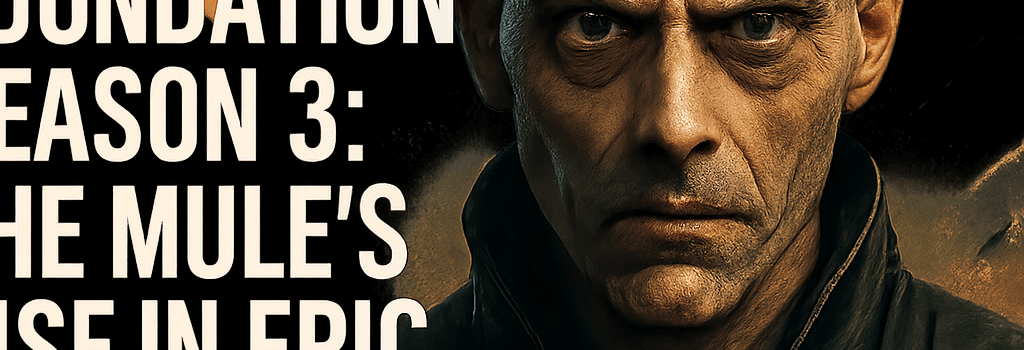Foundation Season 3: The Mule’s Rise in Epic Sci-Fi Saga

From Season 2’s Second Crisis to the Third Crisis
Foundation returns July 11, 2025, on Apple TV+ with a trailer that teases a galaxy under siege. Set 152 years after Season 2’s climactic end, the series picks up with the galaxy in flux: the Foundation has spread its influence far beyond Terminus, while the Cleonic Dynasty’s Empire faces decline. Into this power vacuum steps a warlord known only as The Mule, armed with a combination of military force and insidious mind-control “nudges.”
Where Season 2 dramatized the Second Crisis—Empire versus Foundation—Season 3 thrusts us into the Third Crisis. Hari Seldon’s psychohistorical predictions have always hinged on statistical inevitabilities, but The Mule’s psionic abilities introduce a new variable that threatens the very equations of fate.
“We’re out of time,” warns Gaal Dornick (Lou Llobell) over footage of the Mule’s armies sweeping across star systems.
Key Cast, Characters & New Alliances
- Lee Pace as Brother Day
- Cassian Bilton as Brother Dawn
- Terrence Mann as Brother Dusk
- Jared Harris as Hari Seldon
- Lou Llobell as Gaal Dornick
- Pilou Asbæk as The Mule
New arrivals include Alexander Siddig’s Dr. Ebling Mis, a self-taught psychohistorian; Troy Kotsur’s Preem Palver, leader of a telepathic world; and Cherry Jones as Foundation Ambassador Quent. Industry watchers note that Siddig’s role nods to Asimov’s original influence, while Kotsur’s casting highlights the series’ commitment to inclusive representation.
Technical Deep Dive: Visual Effects & Cloud Rendering
The trailer showcases large-scale space battles and planetary sieges rendered by Industrial Light & Magic (ILM) with a hybrid GPU/CPU cloud pipeline on Amazon Web Services. ILM VFX Supervisor John Hughes confirms that they used AWS Thinkbox Deadline for job scheduling across 30,000 virtual cores and Nvidia A100 GPUs, accelerating render times by 40% compared to on-premises clusters.
- Realistic explosions: volumetric simulations computed with Houdini 19 and OpenVDB libraries.
- Mind-control effects: custom shaders for neural-flare visuals, leveraging machine-learning upscaling via Topaz AI.
- Space environments: procedural asteroid fields and planetary surfaces generated with Substance Designer and Unreal Engine 5.
Filming Technology & Production Workflow
Director David S. Goyer and cinematographer Rob Hardy opted for Arri Alexa LF cameras, capturing key sequences at 8K resolution and 120 fps for slow-motion time-lapses. Lenses from Cooke Optics delivered the signature “cinematic warmth,” while the production team used a private 5G network and edge servers to stream dailies from on-set back to their London post-production facility in under 30 seconds.
Goyer told Variety that an AI-powered dailies tool analyzed focus, exposure, and CG tracking markers in real time, flagging potential reshoot needs within minutes. This DevOps-style feedback loop has become standard for high-end VFX productions, ensuring tight alignment between camera, lighting, and digital teams.
Sound Design & Music: Scoring an Intergalactic Chess Match
Composer Bear McCreary returns with a hybrid score blending a 90-piece orchestra and an analog modular synth rack. According to McCreary, he employed Dolby Atmos mixing to spatialize The Mule’s “psychic nudges”—low-frequency waves designed to trigger unease in the listener, mirroring the narrative’s mind-control theme.
Sound editor Mira Mukerji integrated AI-driven noise reduction tools from iZotope RX NS to clean up location recordings, then layered in synthesized “neuronal pulses” using custom patches in REAPER. The result is an audio landscape that feels both organic and unsettlingly alien.
Narrative & Psychohistory: Science, Stats & Speculation
The show’s depiction of psychohistory—a mathematical sociology forecasting mass human behavior—has inspired real-world research. At MIT’s Center for Collective Intelligence, Dr. Elena Park cites Foundation when discussing agent-based modeling for pandemic forecasting. “While the series takes liberties, it accurately conveys the core challenge: small perturbations can produce outsized effects,” she explains.
Season 3 dramatizes this principle as the Foundation and Empire attempt to incorporate Mule-influenced data points into Seldon’s algorithms. Early leaks suggest that the writers collaborated with a team of data scientists to ensure that the fictional equations maintain logical consistency with chaos theory.
Expert Opinions & Industry Insights
- Showrunner David S. Goyer on tackling large-scale narrative: “Balancing Asimov’s cerebral concepts with blockbuster spectacle has been our north star.”
- ILM VFX Supervisor John Hughes on cloud infrastructure: “AWS allowed us to spin up thousands of cores within minutes—something impossible on legacy hardware.”
- Bear McCreary on merging analog and digital audio: “We wanted the music to echo the show’s theme of human versus machine intelligence.”
Looking Ahead: What the Trailer Doesn’t Show
Insiders hint at a hidden storyline involving a rogue faction within the Cleonic Dynasty testing experimental warp drives. Meanwhile, the leaked script pages reference a flashback to Hari Seldon’s earliest years, offering new insights into his psychohistorical breakthrough. Apple TV+ has neither confirmed nor denied these rumors, but fans are abuzz on social media.
Conclusion: A New Era for Foundation
With Season 3’s release imminent, Foundation stands poised to redefine epic science fiction on streaming platforms. From advanced VFX pipelines in the cloud to psychohistorical debates that mirror today’s data challenges, the series remains as intellectually provocative as it is visually stunning.